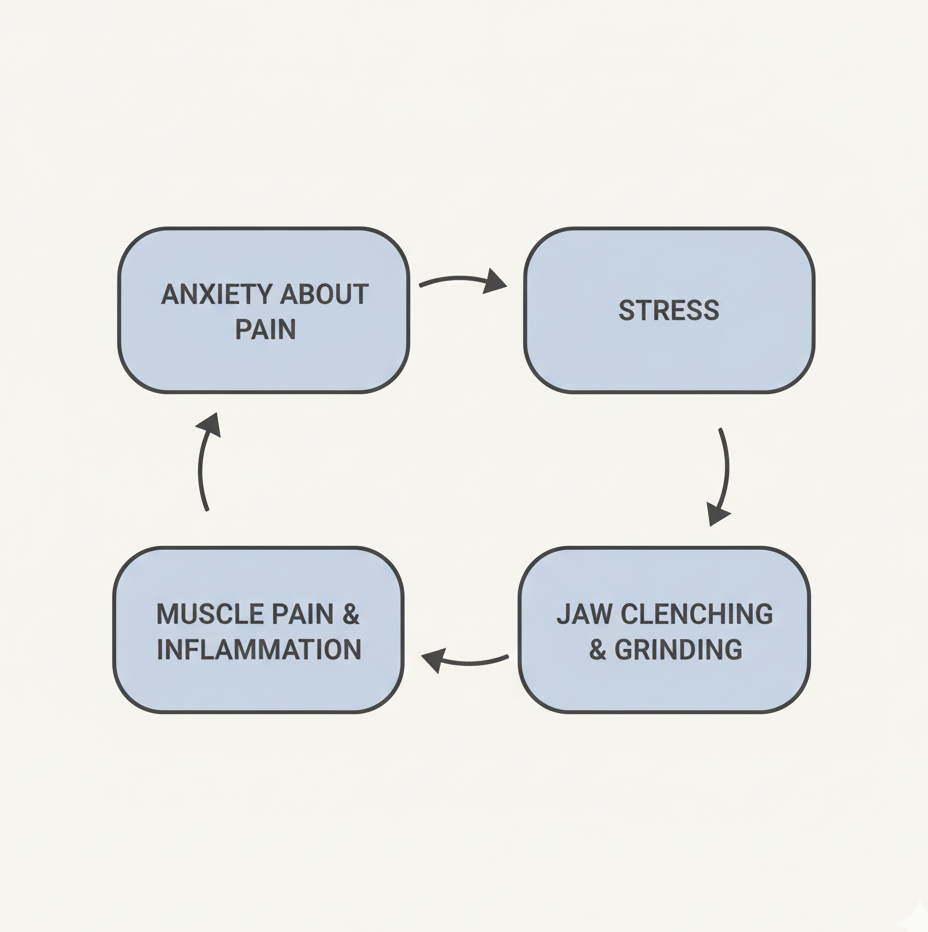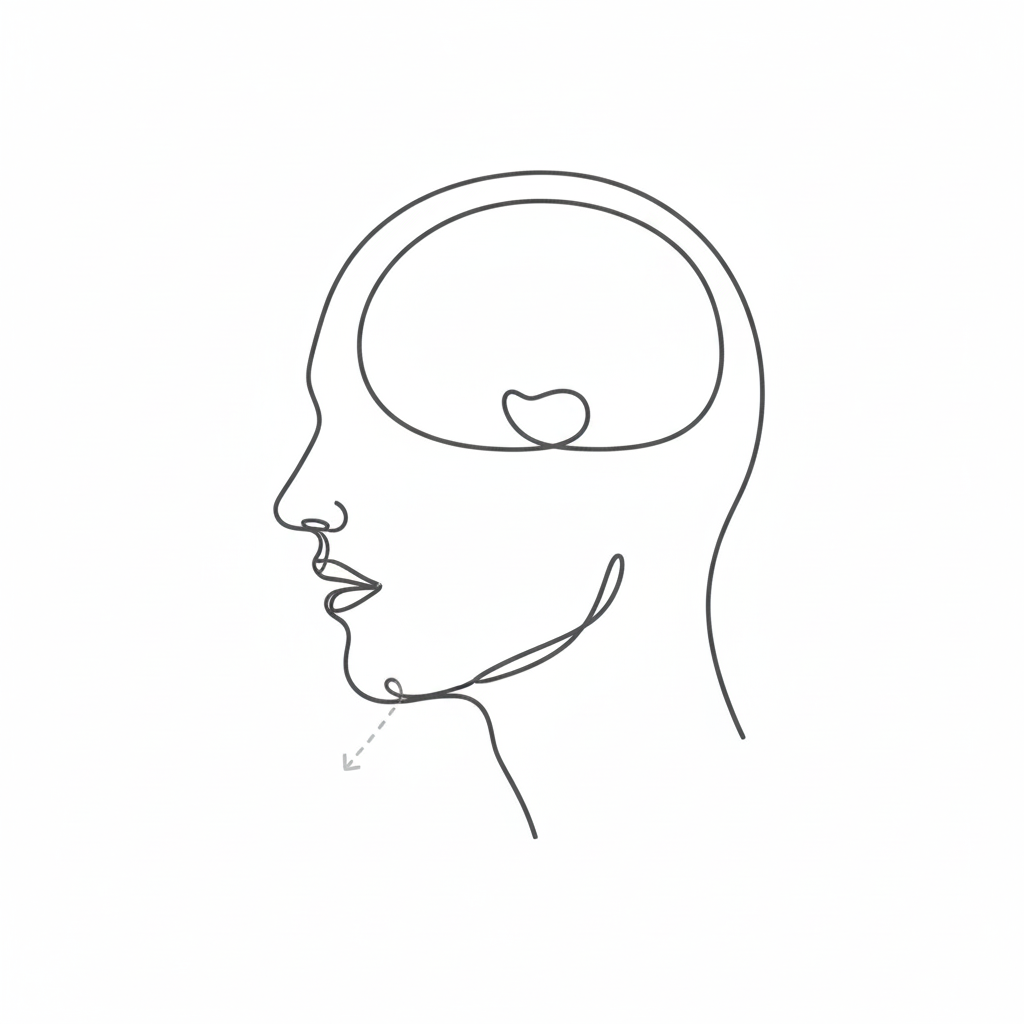TMJ and Stress: Your Complete Guide to Temporomandibular Joint Dysfunction Stress Management
Do you ever catch yourself clenching your jaw during a stressful meeting, while stuck in traffic, or even as you’re trying to fall asleep? That subtle, often unconscious tightening of your facial muscles is more than just a bad habit—it’s your body’s physical response to mental and emotional pressure. For millions of people, this connection between stress and jaw tension manifests as Temporomandibular Joint Dysfunction (TMJ or TMD), a condition that can cause chronic pain, discomfort, and a significant disruption to daily life.
The link between our minds and our bodies is profound, and nowhere is it more evident than in the intricate network of muscles and nerves in our face and jaw. When stress levels rise, the body’s “fight or flight” response kicks in, leading to muscle tension that can overload the delicate temporomandibular joints. This guide is dedicated to exploring and solving this exact issue, providing a complete roadmap for effective temporomandibular joint dysfunction stress management.
The goal of this article is to move beyond simply identifying the problem and to empower you with a toolbox of practical, evidence-based strategies. We will demystify the anatomy of the jaw, explore the physiological cycle that links stress directly to jaw pain, and detail a wide range of solutions. You will learn about medical interventions, powerful mindfulness techniques, targeted physical exercises, and crucial lifestyle adjustments that can bring lasting relief. By understanding and addressing the root cause—stress—you can reclaim control over your symptoms and improve not just your jaw health, but your overall well-being.
What is Temporomandibular Joint Dysfunction (TMJ)?
Before diving into management strategies, it’s essential to understand what TMJ dysfunction is. The temporomandibular joint is one of the most complex joints in your body. Think of it as a sophisticated sliding hinge connecting your jawbone (mandible) to your skull (temporal bone). You have one on each side of your jaw, located just in front of your ears. These joints, along with a network of surrounding muscles, ligaments, and a small shock-absorbing disc, work in harmony to allow you to talk, chew, yawn, and make a wide range of facial expressions.
When this intricate system is thrown out of balance, Temporomandibular Joint Dysfunction (TMD) can occur. It’s not a single condition but rather a cluster of problems affecting the jaw joint and the muscles of mastication (chewing).
Common Symptoms of TMJ Dysfunction Include:
- Pain or Tenderness: The most common complaint is pain in the jaw, in and around the ear, and in the facial muscles.
- Clicking, Popping, or Grating Sounds: You might hear or feel a “pop” or “click” when you open or close your mouth. This sound may or may not be accompanied by pain.
- Limited Movement or Locking: Difficulty opening your mouth wide, or a sensation of the jaw getting “stuck” or “locked” in an open or closed position.
- Headaches: Chronic headaches, often mimicking tension headaches or migraines, are frequently linked to the constant strain in the jaw and temple muscles.
- Ear Pain: Aching pain in or around the ear that isn’t caused by an infection.
- Facial Pain: A tired, aching feeling in the face.
- Difficulty Chewing: Discomfort or pain while eating.
It’s important to differentiate between mild, temporary TMJ issues and a chronic disorder. Many people experience occasional jaw clicking or minor discomfort that resolves on its own. However, for others, TMD becomes a chronic condition with persistent pain that significantly impacts their quality of life, affecting their ability to eat, speak, and even sleep comfortably. With an estimated 10 million Americans affected, understanding TMJ pain causes and seeking proper care is a widespread and pressing need, as noted by authoritative sources like the National Institute of Dental and Craniofacial Research.
How Stress Directly Affects Your TMJ
The connection between your emotional state and physical jaw pain is not just a coincidence; it’s a direct physiological process rooted in your body’s ancient survival mechanisms. When you perceive a threat—whether it’s a looming work deadline, a difficult conversation, or financial anxiety—your brain activates the sympathetic nervous system, triggering the “fight-or-flight” response.
This response floods your body with stress hormones like adrenaline and cortisol. Your heart rate increases, your breathing quickens, and, crucially, your muscles tense up, preparing to either confront the threat or flee from it. The powerful muscles in your jaw, including the masseter and temporalis muscles, are among those that instinctively clench and tighten. In prehistoric times, this might have protected the face from injury. In the modern world, this response often has no physical outlet, leading to prolonged, unconscious tension.

This sustained muscle activity is the primary driver of stress-induced TMJ pain. Two key behaviors are at the center of this problem:
- Jaw Clenching (Diurnal Bruxism): This is the act of tightly clamping your teeth together during the day, often without realizing you’re doing it. You might be concentrating on a task, feeling anxious, or experiencing frustration, and your jaw muscles bear the brunt of that tension.
- Teeth Grinding (Nocturnal Bruxism): This occurs during sleep and is even more insidious because you have no conscious control over it. The forces exerted during sleep grinding can be incredibly powerful, leading to muscle fatigue, tooth wear, and intense morning headaches and jaw pain. Studies have consistently shown a strong correlation between high-stress levels and the frequency and severity of bruxism. One study published in the Journal of Oral Rehabilitation found that individuals reporting high levels of daily stress were significantly more likely to experience bruxism.
This creates a debilitating vicious cycle:
Stress → Jaw Clenching/Grinding → Muscle Fatigue & Inflammation → Jaw Pain & Headaches → Increased Stress & Anxiety about the Pain → More Clenching…
Breaking this cycle is the cornerstone of stress jaw pain management. It requires more than just treating the physical symptoms; it demands a conscious effort to manage the psychological trigger. By learning to regulate your body’s stress response, you can directly reduce the muscle tension that causes and perpetuates TMJ dysfunction.
Medical Approaches to TMJ Stress Management
While managing stress is fundamental to long-term relief, it’s also important to address the immediate physical symptoms of TMJ dysfunction. A healthcare professional, typically a dentist or an oral and maxillofacial specialist, can offer several treatments that provide stability and alleviate pain, giving you the space to work on stress reduction.
These professional TMJ treatment options are designed to protect your jaw and teeth from damage and reduce muscle hyperactivity.
- Custom Oral Splints (Night Guards): One of the most common and effective treatments, a custom-fitted oral splint is a device worn over the teeth, usually at night. It doesn’t stop the grinding reflex, but it acts as a protective barrier. It absorbs the immense forces of clenching and grinding, preventing tooth damage, reducing strain on the jaw joint, and allowing the muscles to relax into a more neutral position.
- Physical Therapy: A qualified physical therapist can be invaluable for TMJ disorder management. They can guide you through specific jaw exercises to strengthen muscles, improve mobility, and promote relaxation. Furthermore, they will often assess and correct postural issues in the neck and upper back, as poor posture (like “tech neck”) can contribute significantly to jaw tension.
- Medications: To break a cycle of acute pain and inflammation, a doctor might recommend short-term use of certain medications.
- Nonsteroidal Anti-Inflammatory Drugs (NSAIDs): Over-the-counter options like ibuprofen can help reduce pain and swelling.
- Muscle Relaxants: In cases of severe clenching or muscle spasms, a prescription muscle relaxant may be used for a brief period, often before bedtime, to help decrease bruxism.
- Botox Injections: For severe, persistent cases of bruxism that don’t respond to other treatments, injections of botulinum toxin (Botox) into the masseter muscles can be an effective option. Botox works by temporarily weakening the muscle, reducing its ability to clench and grind with excessive force. This can provide significant relief from pain and headaches for several months.
It’s crucial to remember that these medical interventions are most effective when viewed as part of a comprehensive strategy. A night guard protects your teeth, but it doesn’t resolve the underlying stress that causes you to grind them in the first place. For lasting relief, these treatments must be paired with active and consistent temporomandibular joint dysfunction stress management.
Stress Management Strategies for TMJ Relief: Your Practical Toolbox
This is where you take active control. Managing stress is not a passive activity; it’s a skill you can develop with a set of proven techniques. Think of this section as your personal toolbox, filled with different approaches to calm your nervous system, release physical tension, and prevent stress from settling in your jaw.
5.1 Mindfulness & Relaxation Techniques: Calming the Nervous System
You notice your jaw tightening during a stressful conference call. Your shoulders are creeping up toward your ears. Instead of letting the tension build, mindfulness allows you to notice this pattern and consciously choose a different response. The science is clear: practices like meditation and deep breathing help lower levels of the stress hormone cortisol, shifting your body from a “fight-or-flight” state to a “rest-and-digest” state, which breaks the clenching reflex. To learn more, read our guide on Practical techniques for Stress Relief.
- Deep Diaphragmatic (Belly) Breathing: This is the fastest way to calm your nervous system.
- Sit or lie down comfortably. Place one hand on your chest and the other on your belly.
- Close your eyes and gently rest your tongue on the roof of your mouth, just behind your front teeth, with your lips lightly closed. This helps the jaw relax.
- Inhale slowly and deeply through your nose for a count of four, feeling your belly expand. Your chest should remain relatively still.
- Hold your breath for a count of seven.
- Exhale slowly and completely through your mouth for a count of eight, making a soft “whoosh” sound. Feel your belly fall.
- Repeat this 4-7-8 cycle three to five times.
- Guided Meditation & Apps: If your mind tends to wander, guided meditation can be a game-changer. Apps like Calm, Headspace, and Insight Timer offer thousands of guided sessions specifically for stress and anxiety. Search for practices focused on “body scan” meditation, which trains you to bring awareness to different parts of your body, including your face and jaw, and release tension.
- Progressive Muscle Relaxation (PMR): This technique highlights the powerful difference between tension and relaxation.
- Find a quiet place to sit comfortably.
- Take a few deep belly breaths.
- Tightly clench the muscles in your jaw for 5 seconds (be gentle, don’t cause pain).
- Completely release the tension and notice the feeling of deep relaxation that follows for 15-20 seconds. Feel the warmth and heaviness.
- Repeat this process for other muscle groups: tense your forehead, then release; clench your fists, then release; shrug your shoulders to your ears, then release. Working through your entire body deepens the overall relaxation response.
Mini Takeaway: Practice a 5-minute guided meditation or a few rounds of 4-7-8 breathing right before you get into bed. This simple ritual can significantly reduce the intensity of nighttime jaw clenching.
5.2 Physical Techniques & Exercises: Releasing Jaw Tension Directly
Stress creates tangible, physical tension in your muscles. While mindfulness calms the mind, these targeted exercises and physical adjustments provide direct relief to the overworked muscles of your jaw, neck, and shoulders. Think of these as a form of TMJ physical therapy you can do at home.

- Gentle Jaw Stretches:
- The Relaxed Jaw Stretch: Rest your tongue on the roof of your mouth. Slowly open your mouth as wide as you comfortably can without pain, while keeping your tongue in position. Hold for 5-10 seconds, then slowly close. Repeat 5 times.
- The Goldfish Exercise (Partial Opening): Place one finger on your chin and another on your TMJ (just in front of your ear). Drop your jaw halfway and then close. You should feel minimal resistance. Repeat 10 times.
- Jaw Mobility Exercises:
- Side-to-Side Movement: Place a thin object, like a pen, between your front teeth. Gently move your jaw from side to side without straining. Repeat 10 times.
- Forward Movement: Gently glide your bottom jaw forward so your bottom teeth are in front of your top teeth. Hold for a moment, then return to neutral. Repeat 10 times.
- Yoga for Neck and Shoulder Release: Tension rarely stays isolated in the jaw. It often originates in or is exacerbated by tightness in the neck and shoulders.
- Neck Rolls: Sit tall. Gently drop your chin to your chest. Slowly roll your right ear toward your right shoulder, feeling the stretch on the left side. Pause, then roll back to center and repeat on the left side. Avoid rolling your head all the way back.
- Child’s Pose (Balasana): This restorative pose releases tension in the back and shoulders. Kneel on the floor, sit back on your heels, and fold forward, resting your forehead on the floor. Let your arms rest alongside your body, palms up. Breathe deeply into your back.
- Supported Fish Pose (Matsyasana): Lie on your back with a rolled-up towel or foam roller placed horizontally under your shoulder blades. This opens up the chest and releases tension in the front of the neck and shoulders, counteracting the effects of hunching over a screen.
- Improve Your Posture and Ergonomics: Constant stress is often paired with poor posture. Hunching over a computer or phone creates a forward-head position that strains the neck muscles, which in turn pull on the jaw.
- Adjust Your Monitor: The top of your computer screen should be at or slightly below eye level.
- Take Micro-Breaks: Set a timer to get up, stretch, and roll your shoulders every 30-45 minutes.
- Be Aware of “Tech Neck”: Hold your phone up closer to eye level instead of looking down at it.
5.3 Lifestyle Adjustments: Removing Daily Triggers
Your daily habits can either fuel the TMJ-stress cycle or help to dismantle it. By making small, conscious adjustments to your routine, you can create an environment that promotes relaxation and reduces strain on your jaw. These lifestyle changes for stress relief are about removing triggers before they have a chance to cause pain.
- Prioritize Sleep Hygiene: A lack of quality sleep significantly reduces your ability to cope with stress, making you more prone to clenching.
- Aim for 7-9 hours of consistent sleep per night.
- Avoid sleeping on your stomach, which can twist your neck and put pressure on your jaw. Try sleeping on your back with a supportive pillow that keeps your head and neck aligned.
- Create a relaxing bedtime routine: turn off screens an hour before bed, take a warm bath, or read a book.
- Mind Your Diet: What you eat can directly impact muscle tension and inflammation.
- Avoid Hard, Chewy, and Tough Foods: Give your jaw a rest. Temporarily cut back on things like chewing gum, tough steak, crusty bread, bagels, and hard candies. Opt for softer foods like soups, smoothies, yogurt, and well-cooked vegetables.
- Limit Stimulants: Caffeine and alcohol can increase anxiety and muscle tension, potentially worsening clenching and grinding, especially at night.
- Boost Magnesium Intake: Magnesium is a vital mineral for muscle relaxation. Many people are deficient. Incorporate magnesium-rich foods like spinach, almonds, avocado, bananas, and dark chocolate into your TMJ diet.
- Stay Hydrated: Dehydration can lead to muscle cramps and stiffness throughout the body, including the jaw muscles. Aim to drink plenty of water throughout the day.
5.4 Complementary & Alternative Approaches: Enhancing Your Relief
While not a substitute for medical advice, these holistic approaches can be excellent additions to your stress management toolkit, providing natural comfort and promoting a deeper state of relaxation.
- Massage Therapy: You can perform self-massage to provide immediate relief. Using your fingertips, apply gentle but firm pressure to the masseter muscles (the bulky muscles on the side of your jaw). Make small circles, and when you find a tender spot, hold the pressure for 30-60 seconds while taking deep breaths. Massaging the temples and neck muscles can also be beneficial.
- Acupuncture: This ancient practice involves inserting thin needles into specific points on the body. Several studies have suggested that acupuncture may help reduce pain and muscle tension associated with TMJ dysfunction by stimulating nerves and altering the perception of pain in the brain.
- Aromatherapy: Certain essential oils have calming properties that can help ease stress. Lavender, chamomile, and bergamot are particularly effective. Use them in a diffuser at your desk or by your bed, or add a few drops to a warm bath. You can also create a diluted roll-on (mixed with a carrier oil like jojoba) and apply it to your temples or just below your earlobe.
- Heat Therapy: Applying gentle heat to the side of your face can help relax tight jaw muscles and increase blood flow. Use a warm, moist compress or a microwaveable herbal heating pad for 15-20 minutes before bed or after a particularly stressful event.
Daily Habits to Break the TMJ–Stress Cycle
Knowledge is only powerful when put into practice. The key to lasting relief is integrating small, stress-reducing habits into your daily life until they become second nature.
- Set “Jaw Check” Reminders: Use your phone or sticky notes to create reminders throughout the day that say, “Relax your jaw.” When you see it, take a moment to notice your posture. Are your teeth touching? Is your tongue on the roof of your mouth? Take a deep breath and let your jaw hang loose.
- The “Lips Together, Teeth Apart” Mantra: Your teeth should only touch when you are chewing. Throughout the day, practice keeping your lips lightly together and your teeth slightly apart. This is the natural, relaxed position for your jaw.
- Take Conscious Stress Breaks: Instead of scrolling through your phone during a break at work, step away from your desk for two minutes. Do a few neck rolls, practice one round of 4-7-8 breathing, and consciously relax your facial muscles.
- Pair Relaxation with Rituals: Link a jaw relaxation exercise to an existing habit. For example, take 30 seconds to do a gentle jaw stretch before you eat each meal, or practice self-massage on your jaw muscles while your tea is steeping in the evening. This makes the habit easier to remember and sustain.
When to See a Professional
While self-care and stress management are incredibly powerful, they are not always enough. It is crucial to recognize the signs that indicate you need professional medical intervention. Delaying treatment can lead to worsening symptoms and more complex problems down the road.
Consult a specialist if you experience:
- Severe, persistent, or worsening pain that isn’t relieved by home care.
- The inability to fully open or close your jaw (a “locked” jaw).
- Chronic, debilitating headaches or migraines.
- Significant difficulty or pain when chewing.
- Noticeable wear on your teeth, which is a sign of severe chronic bruxism.
Who to see:
- Your Dentist: This is usually the best first stop. They can diagnose the issue, rule out other dental problems, and create a custom night guard.
- Oral and Maxillofacial Surgeon: For more complex joint issues.
- Physical Therapist: For specialized exercise and posture correction.
- Your Primary Care Physician: To discuss underlying stress and anxiety and explore comprehensive health solutions.
Don’t hesitate to seek help. Early intervention is key to preventing long-term damage and finding an effective path to relief.
Conclusion: A Holistic Path to a Calmer Jaw and Mind
Temporomandibular Joint Dysfunction is a clear and powerful signal from your body that your physical and emotional health are inextricably linked. It is both a physical condition requiring targeted care and a stress-related condition demanding mental and emotional management. The clicks, pops, and aches are symptoms of an overloaded system, and true relief comes from addressing the entire system, not just the noisy parts.
Effective TMJ and stress management is a journey of building awareness and developing new skills. It involves combining supportive medical treatments like night guards with a dedicated practice of stress management strategies. By learning to calm your nervous system with mindfulness, release physical tension with targeted exercises, and remove daily triggers through lifestyle adjustments, you can break the vicious cycle of pain and stress.
Empower yourself by taking these strategies and building them into your life. Managing stress isn’t just about your jaw—it’s about improving your sleep, your mood, your focus, and your overall health. Your jaw will thank you for it.






